
© Foteini Christofilopoulou, courtesy the Royal Opera House. (Click image for larger version)
The Royal Ballet
Manon
★★★★✰
London, Royal Opera House
29 March 2018
Gallery of pictures by Foteini Christofilopoulou
www.roh.org.uk
It’s a myth that Kenneth MacMillan’s Manon was ever regarded as a failure. Critics may initially have had reservations but audiences have enjoyed it from its first season in 1974 throughout its many revivals: the present season opened with the 266th performance at the Royal Opera House. Indeed, Manon seems to be programmed so regularly that it comes as a surprise to realise it’s been off the stage for the past three years.
Francesca Hayward made her debut as Manon during its last revival in 2014, when she was still a soloist. Now a principal, she replaced injured Laura Morera for the first night of the latest run, with Alexander Campbell as her brother, Lescaut, and Federico Bonelli as her lover, Des Grieux.

© Foteini Christofilopoulou, courtesy the Royal Opera House. (Click image for larger version)
When Hayward’s Manon first steps off the coach in Act I, neither she nor we know who she might be. She puts one foot on pointe tentatively in front of the other, waiting to see how she will be treated. When she makes her entrance in Act II, she’s her own person, no matter who toys with her. The transition is as disturbing to us as it is to her rejected lover.
Hayward starts out as a sweet young thing on her way to a convent, delighted by her effect on the men surrounding her. She’s compliant in her brother’s showing her off, without realising she is being sold to the highest bidder, Monsieur G.M. (Christopher Saunders). She is entranced by Des Grieux’s introductory solo, in which he reveals that he is more shyly virginal than she is. He dances away from her, glancing back at her, not daring to touch her until she responds eagerly. Bonelli still appears youthfully untried, finding his resolve during the solo and then disguising his skill as a partner as she floats in his arms.
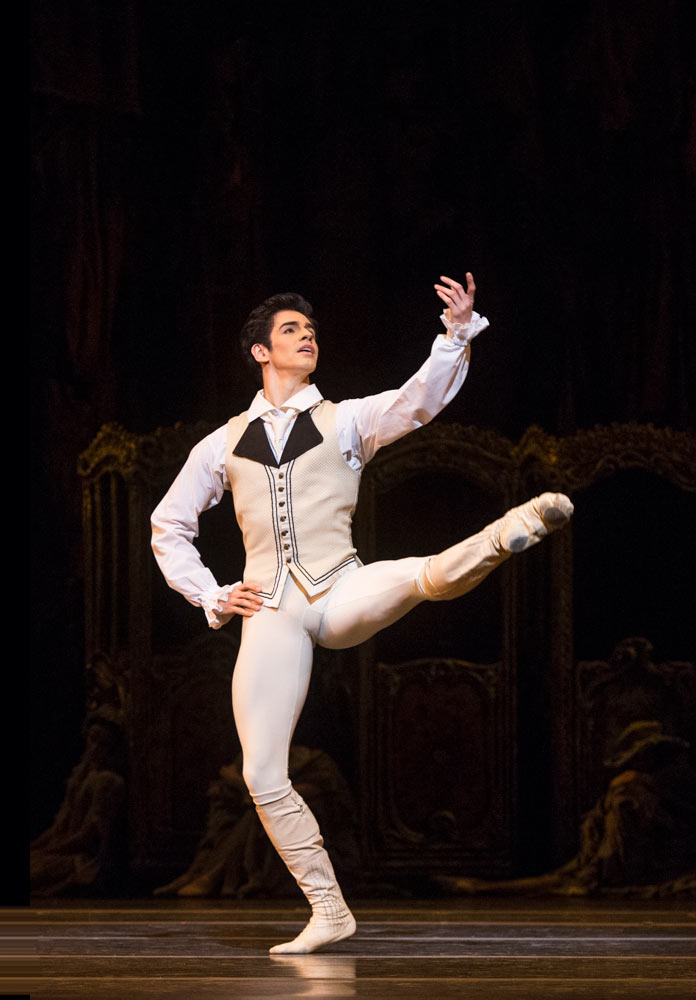
© Foteini Christofilopoulou, courtesy the Royal Opera House. (Click image for larger version)
They run away together, to the chagrin of Lescaut, who promises Monsieur G.M. that he’ll sort this one out. Campbell is a venal fixer, his boyish face peevish except when he’s carousing with fellow rogues – the thieving beggars, led by mercurial James Hay, or the sozzled clients in the plush brothel. His Act I solo, spectacularly danced, promises more than the shallow nastiness Campbell actually delivers as a leading player in the plot.
Hayward’s Manon turns out to be a sensualist, wanting more sex than Des Grieux is experienced enough to provide. She is capricious, while he is preoccupied by how they are going to be able to live. She flings herself onto their bed when he leaves, only to slither forward when Lescaut arrives as her pimp with Monsieur G.M. in tow. Hayward succeeds in revealing how repulsive she finds the slavering foot-fetishist ‘protector’, while calculating what she will gain from the arrangement. Her arms, fresh from embracing Des Grieux, are now ready for furs and jewels, like the diamond halter around her neck.

© Foteini Christofilopoulou, courtesy the Royal Opera House. (Click image for larger version)
Yet she doesn’t believe that she has been bought. In Manon’s only solo, as the belle of the bordello, she twines her arms above her head as though she’s in control of her sexuality, deserving to be admired and rewarded with yet more jewellery. Though Hayward appears vulnerable because she’s so slight, her Manon is out for what she can get – including Des Grieux back again.
But because he wants her so desperately – and this is where Bonelli blazes into passion at last – he’s not going to be enough for her. Hayward doesn’t yet have the measure of Manon’s emptiness: her facial expressions can’t be read clearly enough, unlike the vividness of her dancing. She does, though, convey how traumatised she has become in Act III by the Gaoler’s brutality and by her ordeal in the swamp of Louisiana. She doesn’t fight death so much as succumb to the horrors in her head. Bonelli tries to bring her back from her frenzy, not realising that she’s dying. It’s a sadder, more pathetic ending than the acrobatic hurling about of more defiant Manons, refusing to surrender.
The last act has changed over the years, mostly for the better. Superfluous dances for the inhabitants of the penal colony in Louisiana have been cut, and the formation fainting of the deported prostitutes somewhat disguised. The quayside of New Orleans is properly unlovely, haunted by the omnipresent rags of Nicholas Georgiadis’s setting for the ballet. The Gaoler (Gary Avis, vile as ever) now operates from within a rundown warehouse instead of a cool shuttered office.

© Foteini Christofilopoulou, courtesy the Royal Opera House. (Click image for larger version)
Martin Yates, who conducted the performance, amplified Leighton Lucas’s orchestration of Massenet’s music back in 2011, making it sound less thinly elegiac, more like a dramatic film score. Luxury casting for the opening night gave us classy courtesans (Yuhui Choe and Beatriz Stix-Brunell as rivals) and fleet-footed gentleman clients (Matthew Ball, William Bracewell and Marcelino Sambé). Claire Calvert as Lescaut’s mistress is a tolerant toughie with a touch of Myrtha, Queen of the Wilis, ready to take over from Elizabeth McGorian’s elegant Madame of the house of ill repute, when the time comes. She’s worldly wise enough to avoid Manon’s fate, and that of chancer Lescaut. Since all the characters have their own back-stories, there’s always something going on in the crowd scenes, if you can tear your eyes away from the main characters. So far, not too distracting, since the performers have obviously been well coached.
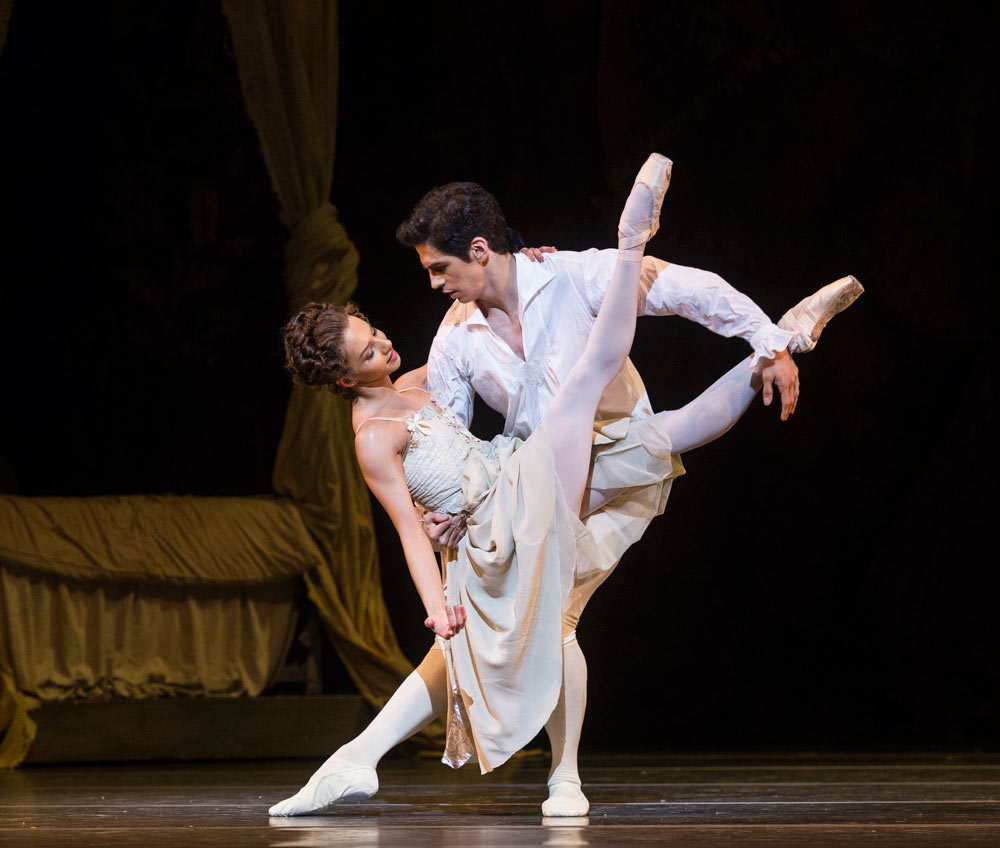
© Foteini Christofilopoulou, courtesy the Royal Opera House. (Click image for larger version)
Welcome back, Manon, with the many casts yet to come.












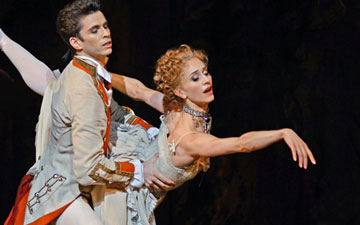


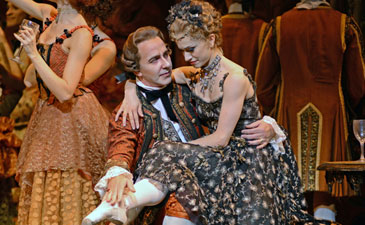
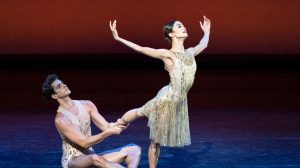
Terrific piece by Jann Parry as always, but the captioning of the Saunders/brothel pic is inadequate and disrespectful of the other featured dancers.
Thanks for your observation Luke – when you run lots of pictures, which papers tend not to (even on the web where there is room) one doesn’t always achieve the wonderfulness in captioning that one might with even more time and effort devoted to it all. In this case, I’ve just realised that the picture was a ‘rogue’ shot and not one of the 15 we are allowed to run – so it’s now removed.
An interesting review, but I can’t understand you not being able to read Hayward’s facial expressions. I find her one of the most expressive dancers facially, as well as in the body. She shows her emotions genuinely, without the stagy over-acting, or fixed-on looks, that seem to characterise some other principals.
Also you could have given a lot more credit to Campbell for the sheer punch and flair in his dancing – as well as his brilliant comic drunken scenes, including with Calvert- so well timed between them, and providing a knowing little send-up of pas-de-deux.
From where I was sitting, Hayward needs stronger makeup for visibility for those not resorting to binoculars. The same used to be true of Alina Cojocaru in her early Royal Ballet career. Campbell dances marvellously but his characterisation remains unplumbed – and the drunken pas de deux could be subtler.
Thanks for your response, Jann. I’m sorry you couldn’t see Hayward’s face well enough from your seat, but I think that applying more makeup would tend to mask, rather than enhance, her sublety of expression.
I found Campbell’s drunken pas de deux acting perfectly pitched, and I am not sure what you mean by “his characterisation remains unplumbed”.
Anyway, it will be interesting to see how he performs Des Grieux, now that he is standing in for the injured McRae.
I attended Manon on May 1, and from E 31 Stalls Hayward’s face was a miracle of expressiveness. Every nuance and layer of what she intended to portray was clear from moment to moment (aided by a perfect make-up by the way). What a charismatic performance! And I haven’t even yet mentioned Hayward’s lines, technique and beautiful port-de-bras – the latter being a rare thing nowadays. She put a certain ballerina, who comes from a region that supposedly specialises in port-de-bras, to shame. Kudos also to Federico Bonelli, Alexander Campbell and Claire Calvert, in whose Mistress I could not discern a single trace of Myrthe, she was just a vulnerable girl, who hid her fear for ending up on transport behind a façade of self-confidence that cracked now and then. May the Royal Ballet long continue to give performances like this!
Of course, in my findings above I didn’t mean to say Jann Parry, a dance writer/critic who is as wise as she is experienced, was wrong. Hayward might have had first-night nerves, read Parry’s review, her performance may have grown over the weeks – or my opinion simply differs